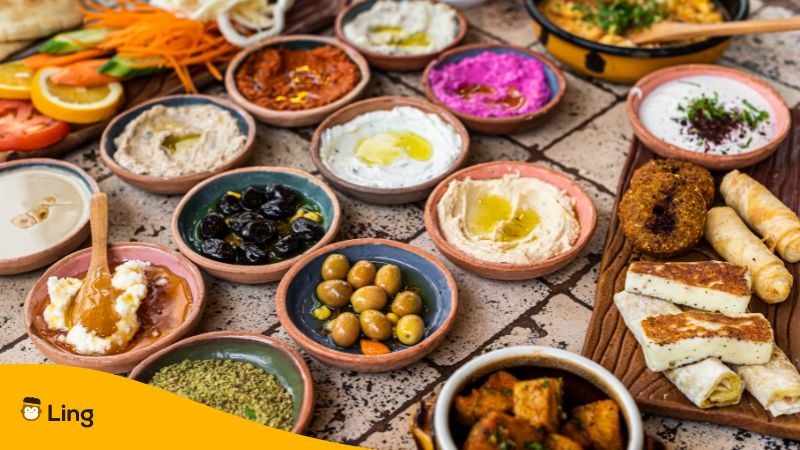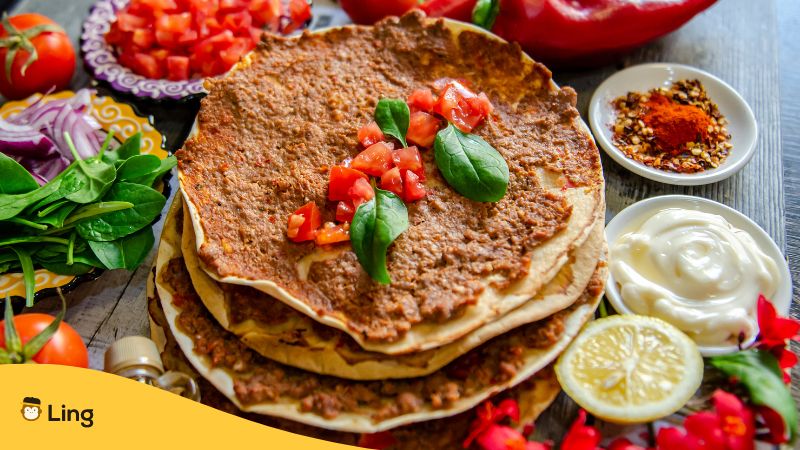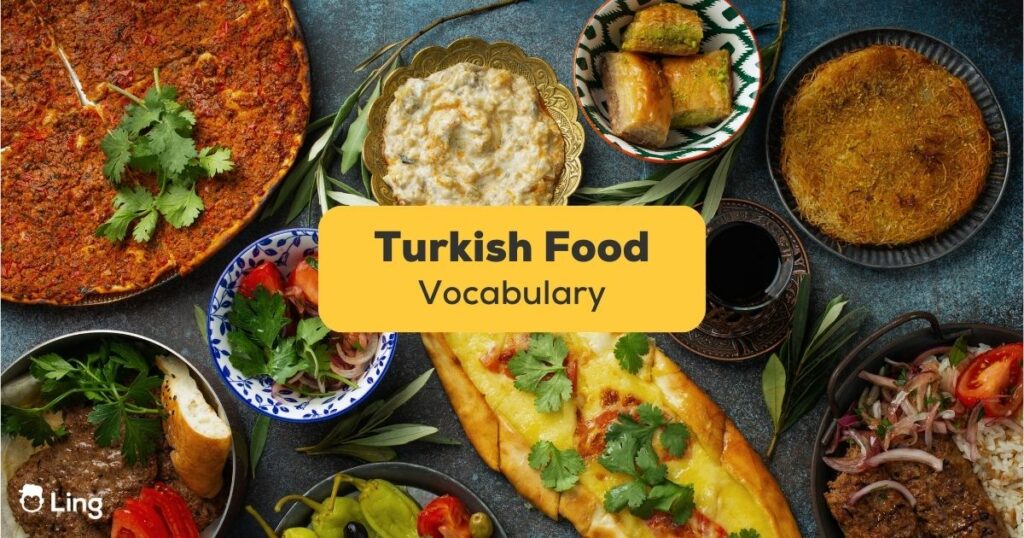Turkish cuisine is a delightful blend of flavors, aromas, and textures that has captivated food enthusiasts around the world. From succulent kebabs to rich pastries, the gastronomic offerings of Turkey reflect its rich history and diverse culture.
In this article, we’ll dive into the captivating world of Turkish food vocabulary, exploring the names of various dishes and ingredients that make this cuisine so special.
Essential Turkish Food Vocabulary
Turkish cuisine has transcended borders, gaining popularity worldwide. From “döner kebab” stands on European streets to upscale Turkish restaurants in North America, the global community has embraced the savory and sweet delights of Turkish gastronomy.
Let’s deep dive into the vocabulary used in and for the delightful Turkish food.
The Basics: Meat, Vegetables, And Grains
In Turkish cuisine, fresh ingredients are the foundation of every dish. Here are some essential food items.
Spices
Turkish cuisine is renowned for its skillful use of spices and herbs. Some key ones include:
| English | Turkish | Pronunciation |
|---|---|---|
| Cumin | Kimyon | |
| Thyme | Kekik | |
| Red pepper flakes | Pul biber | |
| Chili pepper | Acı pul biber | |
| Pepper | Karabiber | |
| Salt | Tuz | |
| Vinegar | Sirke | |
| Mayonnaise | Mayonez | |
| Mustard | Hardal |

Turkish Desserts
Indulge in the exquisite world of Turkish desserts with the following vocabulary:
| English | Turkish | Pronunciation |
|---|---|---|
| Dessert | Tatlı | |
| Cake | Pasta | |
| Candy | Şeker | |
| Chocolate | Çikolata | |
| Cookies | Bisküvi | |
| Baklava | Baklava | |
| Turkish Delight | Lokum |
Beverages
Quench your thirst and add flavor with these:
| English | Turkish | Pronunciation |
|---|---|---|
| Coffee | Kahve | |
| Tea | Çay | |
| Water | Su | |
| Mineral water | Maden suyu | |
| Fruit juice | Meyve suyu | |
| Milk | Süt | |
| Cola | Kola | |
| Beer | Bira | |
| Wine | Şarap |
Food Terms
Understand meal times and dining terminology in Turkish:
| English | Turkish | English | Pronunciation |
|---|---|---|---|
| Breakfast | Kahvaltı | ||
| Lunch | Öğle yemeği | ||
| Dinner | Akşam yemeği | ||
| Starter | Meze | ||
| Main course | Ana yemek | ||
| Vegetarian | Vejetaryen | ||
| Vegan | Vegan | ||
| Gluten-free | Glutensiz |
Exploring Popular Turkish Dishes
Now let’s take a look at some of the most unique, popular Turkish dishes that hold a special place in the heart of the Turkish people.
1. Adana Kebab: A Spicy Delight
“Adana kebab” is a mouthwatering dish named after the city of Adana. It’s made from minced meat, often lamb, mixed with “biber salçası” (red pepper paste) and a blend of spices. The mixture is then molded onto skewers and grilled to perfection, resulting in a spicy and flavorful kebab.
2. Lahmacun: The Turkish Pizza
“Lahmacun” is often referred to as Turkish pizza. It features a thin dough topped with a mixture of minced meat, onions, tomatoes, and spices. After baking, it’s garnished with fresh vegetables and a squeeze of lemon, adding zing to every bite.
3. Börek: Layers of Flaky Goodness
“Börek” is a savory pastry that comes in various forms, but all are made with thin layers of dough. The layers are filled with ingredients like cheese, spinach, or minced meat, then baked until golden and flaky. It’s a popular snack enjoyed throughout the day.

Cultural Significance Of Turkish Cuisine
Turkish cuisine is a reflection of the country’s history as a crossroads between East and West. Influences from the Ottoman Empire, the Middle East, Central Asia, and the Mediterranean have all shaped the diverse flavors and techniques found in Turkish cooking.
Turkish meals are often communal experiences, bringing friends and family together. The act of sharing dishes like “mezze” (appetizers) or a hearty “keşkek” (wheat and meat porridge) fosters connections and strengthens relationships.
Mastering Turkish Cooking: Tips for Beginners
Here are a few quick tips on mastering the Turkish cooking, especially useful for complete beginners.
Using Spice Blends
Experimenting with Turkish spices is a delightful journey. Create your own “karışık baharat” (mixed spice blend) by combining cumin, paprika, and other spices. This blend can be used to marinate meats or elevate the flavor of rice and vegetables.
Cooking Techniques
Exploring Turkish cooking techniques opens up a world of possibilities. Try your hand at “sac tava” (pan cooking) for a sizzling meat and vegetable medley, or delve into “simit” (ring-shaped bread) making for a taste of Turkey’s street food culture.

Conclusion
Embarking on a culinary journey through Turkey means encountering flavors that tell stories of tradition, history, and innovation. Whether you’re wandering through bustling bazaars or enjoying a meal in a quaint village, every bite is a taste of Turkish culture.
Turkish food vocabulary encompasses not just words but a rich tapestry of culture and heritage. From succulent kebabs to aromatic spices, every element contributes to an experience that’s both satisfying and enlightening. So, the next time you savor a “çay” (tea) or dig into a plate of “pide” (Turkish pizza), remember that you’re partaking in a culinary tradition that spans centuries.
FAQs About Turkish Foods
- Is Turkish cuisine spicy? Turkish cuisine features a variety of flavors, and while some dishes can be spicy, not all are. It’s all about finding the balance that suits your palate.
- What’s the significance of “meze” in Turkish meals? “Meze” refers to a selection of small dishes served as appetizers. They’re meant to be shared and enjoyed before the main course, fostering a sense of togetherness.
- Are vegetarian options common in Turkish cuisine? Absolutely. Turkish cuisine offers a plethora of vegetarian dishes like “imam bayıldı” (stuffed eggplant) and “mercimek çorbası” (lentil soup) that are full of flavor.
- What’s the secret behind the perfect “baklava” layers? Achieving the delicate layers of “baklava” requires patience and precision while stretching the dough thinly. Generously buttering each layer is key to that perfect flakiness.
- How does Turkish tea culture differ from other countries? In Turkey, tea is not just a beverage; it’s a symbol of hospitality. It’s often offered as a welcoming gesture to guests and is typically served in small, tulip-shaped glasses.
Start Learning Turkish With Ling!
Are you looking for the best app to learn Turkish? Then you’ve come to the right place!
Ling is the best language-learning app for learning conversational Turkish in a short period of time. What sets Ling apart from other language learning apps is its interactive exercises, real-life vocabulary, and focus on conversational skills such as pronunciation and speaking.
But that’s not all! Other fantastic features of Ling are engaging writing and listening exercises, real-life vocabulary and phrases, voice recognition for improving pronunciation, revision quizzes, and the bonus of AI chatbots for practicing everyday conversations.
Don’t wait any longer to learn Turkish! Download Ling now from the App Store or Play Store and connect through language today!
Also, remember to check our Turkish blog for new articles every week to learn more about the Turkish language and culture!
Görüşürüz!



































































